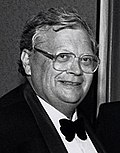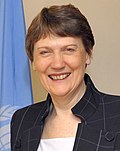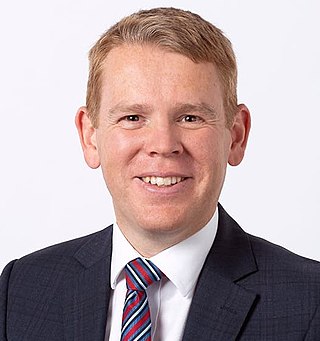Leader of the New Zealand Labour Party
Highest ranked politician within the party From Wikipedia, the free encyclopedia
The leader of the Labour Party is the highest-ranked political position within the New Zealand Labour Party, who serves as the parliamentary leader and leading spokesperson of the party. The current leader is Chris Hipkins, after Jacinda Ardern resigned.
| Leader of the Labour Party | |
|---|---|
| Term length | No fixed term1 |
| Inaugural holder | Alfred Hindmarsh |
| Formation | 7 July 1916 |
| Deputy | Deputy Leader of the New Zealand Labour Party |
| Website | Labour Party profile |
| 1. The leader must be endorsed by the party caucus following a general election, usually every three years, but this does not automatically trigger a new leadership election. | |
History
The post of leader of the Labour Party was officially created upon the party's inception in 1916, though the title "leader" was often substituted and/or complemented with the title "chairman".[1] At the 1935 election, Michael Joseph Savage led the Labour Party to victory, becoming the first Labour prime minister. In 1963, Arnold Nordmeyer became the first New Zealand-born leader of the party; three previous leaders had been born in Australia and one each in England and Scotland. The most electorally successful Labour leader to date is Helen Clark, who won three elections, in 1999, 2002 and 2005. Clark is also the party's longest-serving leader, having served for 14 years, 346 days between 1993 and 2008.[2] Peter Fraser is the longest-serving Labour prime minister, serving 9 years, 261 days between 1940 and 1949.
Selection
A leadership candidate must be a member of parliament (MP). A new leader is elected whenever a vacancy arises, whether due to resignation, incapacitation, or following a motion of no confidence by the parliamentary caucus.[3]
The current election rules were adopted in 2021, replacing earlier rules adopted in 2012.[4] Candidates need 10% of the caucus to nominate. The caucus votes via exhaustive ballot (absent MPs can vote by proxy), and a candidate requires the support of two-thirds of the caucus to be elected. If no one can get two-thirds the candidate with the fewest votes is eliminated.[5] If there are two candidates left and neither got two-thirds, there may be multiple rounds of voting to identify a consensus candidate. If one cannot be found then the leadership is determined by an electoral college comprising the caucus (40% of the total vote), party members (40%) and affiliated trade unions (20%).[4]
No later than three months following a general election, there must be a caucus vote to endorse the leader. If they fail to receive endorsement then the position of party leader is vacated and an election is triggered.[3]
Role
When the Labour Party forms the Parliamentary Opposition, as is the case now, the party leader commonly takes on the position of the leader of the Opposition and chairs a Shadow Cabinet. Likewise, when the party is in Government, the leader typically becomes the prime minister.[6]
Unique to Labour, the party's caucus possesses the right to elect MPs to Cabinet, rather than the leader choosing them. The practice began following the 1940 leadership election.[7] Michael Joseph Savage was the only leader to solely appoint his own cabinet following the election victories in 1935 and 1938.
List of leaders
Summarize
Perspective
The following is a complete list of Labour Party leaders (including acting leaders):
Key:
Labour
Reform
United
National
PM: Prime Minister
LO: Leader of the Opposition
†: Died in office
| No. | Leader (Birth–Death) |
Portrait | Electorate | Term Began | Term Ended | Time in Office | Position | Prime Minister | ||
|---|---|---|---|---|---|---|---|---|---|---|
| 1 | Alfred Hindmarsh (1860–1918) |
 |
Wellington South | 7 July 1916 | 13 November 1918† | 2 years, 129 days | — | Massey 1912–25 | ||
| 2 | Harry Holland (1868–1933) |
 |
Grey (1918–19) Buller (1919–33) |
27 August 1919 | 8 October 1933† | 14 years, 42 days | — | |||
| Bell 1925 | ||||||||||
| LO 1926–1928 | Coates | |||||||||
| Junior coalition partner 1928–1931 |
Ward | |||||||||
| LO 1931–1933 | Forbes | |||||||||
| 3 | Michael Joseph Savage (1872–1940) |
 |
Auckland West | 12 October 1933 | 27 March 1940† | 6 years, 167 days | LO 1933–1935 | |||
| PM 1935–1940 | himself | |||||||||
| 4 | Peter Fraser (1884–1950) |
 |
Wellington Central (1918–46) Brooklyn (1946–50) |
1 April 1940 | 12 December 1950† | 10 years, 255 days | PM 1940–1949 | himself | ||
| LO 1949–1950 | Holland 1949–57 | |||||||||
| 5 | Walter Nash (1882–1968) |
 |
Hutt | 17 January 1951 | 31 March 1963 | 12 years, 73 days | LO 1951–1957 | |||
| Holyoake 1957 | ||||||||||
| PM 1957–1960 | himself | |||||||||
| LO 1960–1963 | Holyoake 1960–72 | |||||||||
| 6 | Arnold Nordmeyer (1901–1989) |
 |
Island Bay | 1 April 1963 | 16 December 1965 | 2 years, 259 days | LO 1963–1965 | |||
| 7 | Norman Kirk (1923–1974) |
 |
Lyttelton (1957–69) Sydenham (1969–74) |
16 December 1965 | 31 August 1974† | 8 years, 258 days | LO 1965–1972 | |||
| Marshall 1972 | ||||||||||
| PM 1972–1974 | himself | |||||||||
| – | Hugh Watt[note 1] (1912–1980) |
 |
Onehunga | 31 August 1974 | 6 September 1974 | 7 days | PM 1974 | himself | ||
| 8 | Bill Rowling (1927–1995) |
 |
Tasman | 6 September 1974 | 3 February 1983 | 8 years, 150 days | PM 1974–1975 | himself | ||
| LO 1975–1983 | Muldoon | |||||||||
| 9 | David Lange (1942–2005) |
 |
Mangere | 3 February 1983 | 8 August 1989 | 6 years, 186 days | LO 1983–1984 | |||
| PM 1984–1989 | himself | |||||||||
| 10 | Geoffrey Palmer (born 1942) |
 |
Christchurch Central | 8 August 1989 | 4 September 1990 | 1 year, 27 days | PM 1989–1990 | himself | ||
| 11 | Mike Moore (1949–2020) |
 |
Christchurch North | 4 September 1990 | 1 December 1993 | 3 years, 88 days | PM 1990 | himself | ||
| LO 1990–1993 | Bolger 1990–97 | |||||||||
| 12 | Helen Clark (born 1950) |
 |
Mount Albert | 1 December 1993 | 11 November 2008 | 14 years, 346 days | LO 1993–1999 | |||
| Shipley 1997–99 | ||||||||||
| PM 1999–2008 | herself | |||||||||
| 13 | Phil Goff (born 1953) |
 |
Mount Roskill | 11 November 2008 | 13 December 2011 | 3 years, 32 days | LO 2008–2011 | Key 2008–16 | ||
| 14 | David Shearer (born 1957) |
 |
Mount Albert | 13 December 2011 | 15 September 2013 | 1 year, 276 days | LO 2011–2013 | |||
| 15 | David Cunliffe (born 1963) |
 |
New Lynn | 15 September 2013 | 30 September 2014 | 1 year, 15 days | LO 2013–2014 | |||
| – | David Parker[note 1] (born 1960) |
 |
List MP | 30 September 2014 | 18 November 2014 | 49 days | LO 2014 | |||
| 16 | Andrew Little (born 1965) |
 |
List MP | 18 November 2014 | 1 August 2017 | 2 years, 256 days | LO 2014–2017 | |||
| English 2016–17 | ||||||||||
| 17 | Jacinda Ardern (born 1980) |
 |
Mount Albert | 1 August 2017 | 22 January 2023 | 5 years, 174 days | LO 2017 | |||
| PM 2017–2023 | herself | |||||||||
| 18 | Chris Hipkins (born 1978) |
 |
Remutaka | 22 January 2023 | Incumbent | 2 years, 89 days | PM 2023 | himself | ||
| LO 2023–present | Luxon 2023–present | |||||||||
- Deputy leader who assumed the role of party leader temporarily because of the death or resignation of the incumbent, serving until the election of a new leader.
Timeline

See also
References
Wikiwand - on
Seamless Wikipedia browsing. On steroids.

